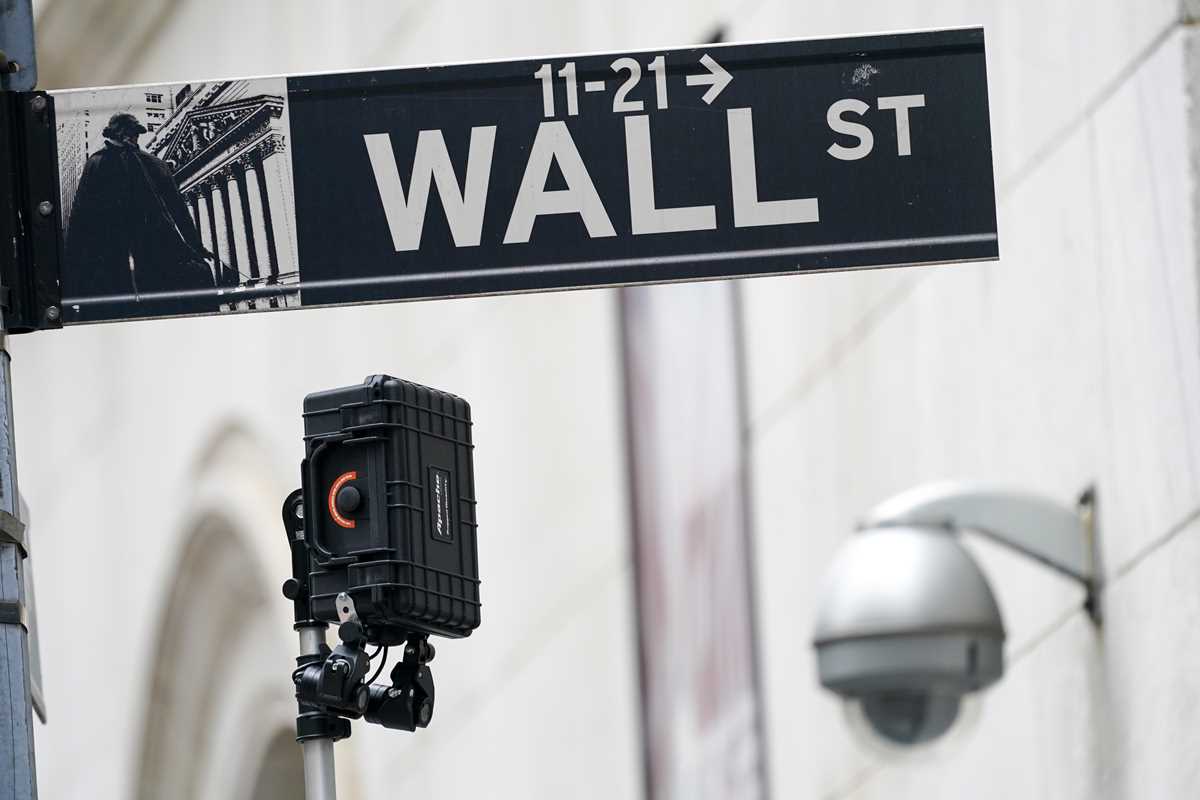 A Wall Street sign is seen next to surveillance equipment outside the New York Stock Exchange, Tuesday, Oct. 5, 2021, in New York. Stocks fell in morning trading Wednesday, Oct. 6, 2021 as Wall Street undergoes a bout of volatility, driven in part by big swings in technology companies. The S&P 500 fell 0.8%. The benchmark index has risen or fallen by more than 1% the past four days. The Dow Jones Industrial Average slipped 1% and the Nasdaq fell 0.6%. International markets also sold off, with exchanges in Japan, South Korea, Germany and France all dropping more than 1%. (AP Photo/Mary Altaffer)
A Wall Street sign is seen next to surveillance equipment outside the New York Stock Exchange, Tuesday, Oct. 5, 2021, in New York. Stocks fell in morning trading Wednesday, Oct. 6, 2021 as Wall Street undergoes a bout of volatility, driven in part by big swings in technology companies. The S&P 500 fell 0.8%. The benchmark index has risen or fallen by more than 1% the past four days. The Dow Jones Industrial Average slipped 1% and the Nasdaq fell 0.6%. International markets also sold off, with exchanges in Japan, South Korea, Germany and France all dropping more than 1%. (AP Photo/Mary Altaffer)Stock indexes edged higher on Wall Street Wednesday afternoon, regaining their footing after a bout of choppy trading earlier in the day.
The S&P 500 rose 0.2% as of 2:19 p.m. Eastern after having been down 1.3% earlier. Gains in technology stocks and companies that rely on consumer spending helped offset losses in health care, energy and other sectors. Still, about 57% of stocks in the benchmark index were down, and it has risen or fallen more than 1% on each of the past four days.
The Dow Jones Industrial Average rose 50 points, or 0.2%, to 34,365. The blue-chip index had been down more than 450 points in the early going. The tech-heavy Nasdaq was up 0.3% after swaying between small gains and losses.
Small-company stocks, a gauge of confidence in economic growth, fell: The Russell 2000 index was down 0.8%.
Technology stocks have swung between gains and losses as investors reassess whether stocks have grown too expensive, particularly high-priced technology companies. Cisco Systems fell 1.7%, while Microsoft rose 1.3%.
The market volatility comes as investors question the economy's path forward, amid rising inflation and the ongoing impact from the virus pandemic. Bond yields have remained relatively stable since a sharp jump late last month that signaled concern that high inflation could linger longer than economists and investors had initially anticipated.
The yield on the 10-year Treasury held steady at 1.53%. It was as low as 1.32% a little more than two weeks ago. The drop in bond yields weighed on banks, which rely on higher yields to charge more lucrative interest on loans. Citigroup fell 0.6%.
Energy prices are retreating after a strong rally that contributed to inflation fears. U.S. crude oil fell 2% and natural gas plunged 9.7%. The drop weighed on energy companies. Exxon Mobil fell 1.9%.
International markets also sold off, with exchanges in Japan, South Korea, Germany and France all dropping more than 1%.
Investors are grappling with a long list of uncertainties, and that could mean a more durable pullback in stocks than Wall Street has experienced so far this year, said Sameer Samana, senior global market strategist at Wells Fargo Investment Institute. Inflation and the debt ceiling timeline in Washington are both key concerns, he said.
Wall Street is also still closely watching the Federal Reserve for any shift in timing for raising interest rates. Analysts have said that the central bank could act sooner than expected if high inflation persists.
“The investment case for those looking for further gains, at least this year, was the expectation that rates would stay at fairly low levels,” Samana said.
Investors will get a closer look at how companies fared in the third quarter when companies release their quarterly financial results over the coming weeks. Wall Street is expecting solid profit growth of 27% for S&P 500 companies, but will also be listening for commentary on how supply chain problems and higher costs are crimping operations.
Companies from a wide range of industries have issued warnings about supply chain problems, shipping delays and higher materials costs. Some companies are growing more concerned that the problem could stretch into the holiday shopping season that typically starts in late November. Toy companies are racing to get their products to retailers as they grapple with a severe supply chain crunch that could mean sparse shelves for the crucial holidays.
Homebuilder Hovnanian slumped 13.7% after warning investors that supply shortages will hurt its finances. Lighting maker Acuity Brands jumped 11.3% after handily beating analysts' fiscal fourth-quarter profit forecasts.
On Friday, the Labor Department will release its anticipated employment report for September. The labor market has been slow to fully recover from the pandemic and the summer surge in COVID-19 cases further impeded its progress.
Before you consider Wells Fargo & Company, you'll want to hear this.
MarketBeat keeps track of Wall Street's top-rated and best performing research analysts and the stocks they recommend to their clients on a daily basis. MarketBeat has identified the five stocks that top analysts are quietly whispering to their clients to buy now before the broader market catches on... and Wells Fargo & Company wasn't on the list.
While Wells Fargo & Company currently has a "Hold" rating among analysts, top-rated analysts believe these five stocks are better buys.
View The Five Stocks Here
Wondering when you'll finally be able to invest in SpaceX, StarLink, or The Boring Company? Click the link below to learn when Elon Musk will let these companies finally IPO.
Get This Free Report